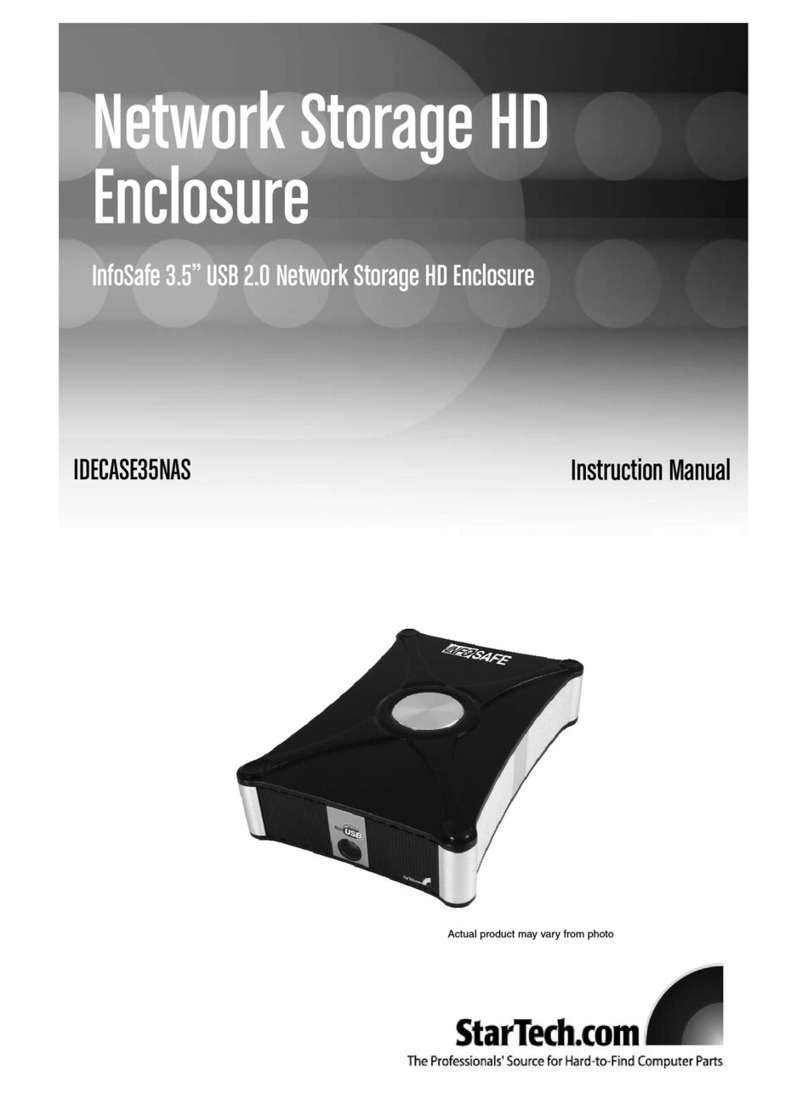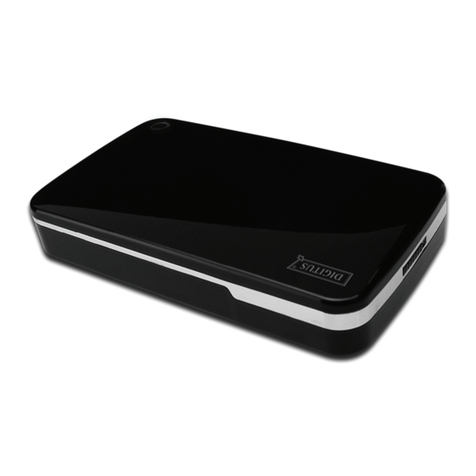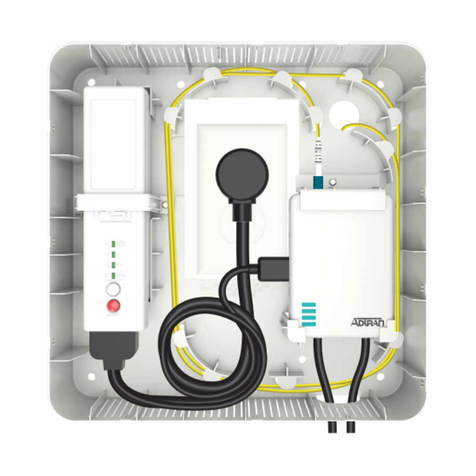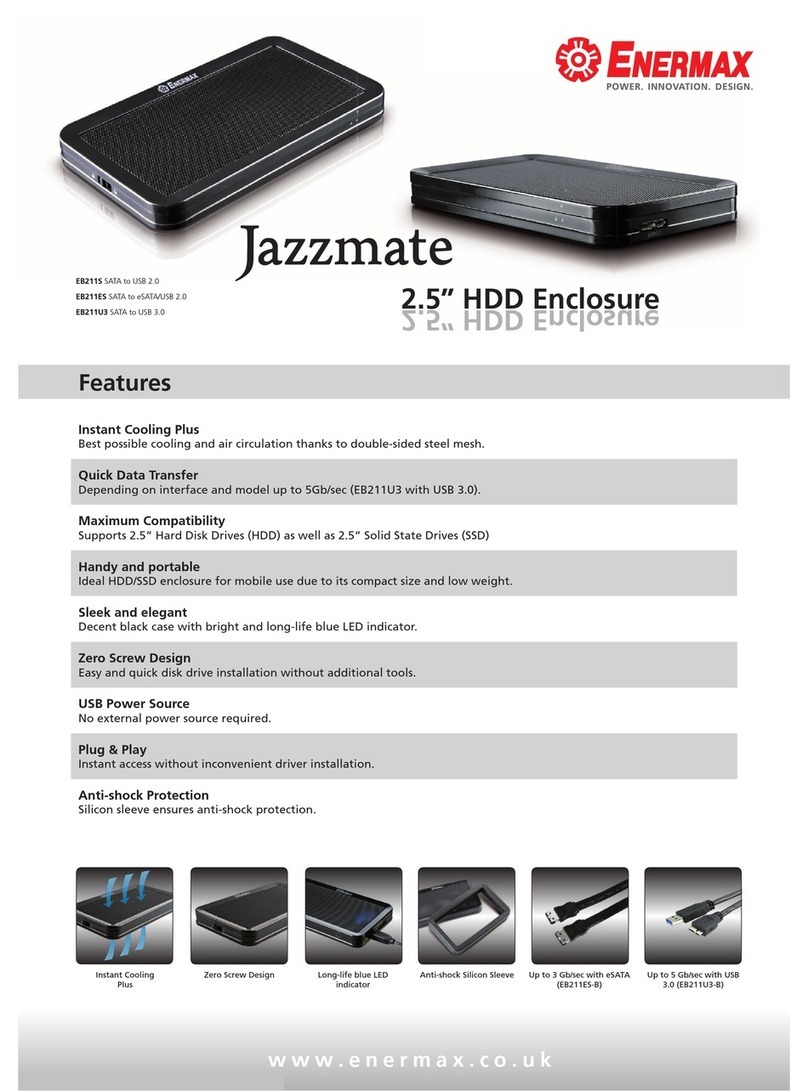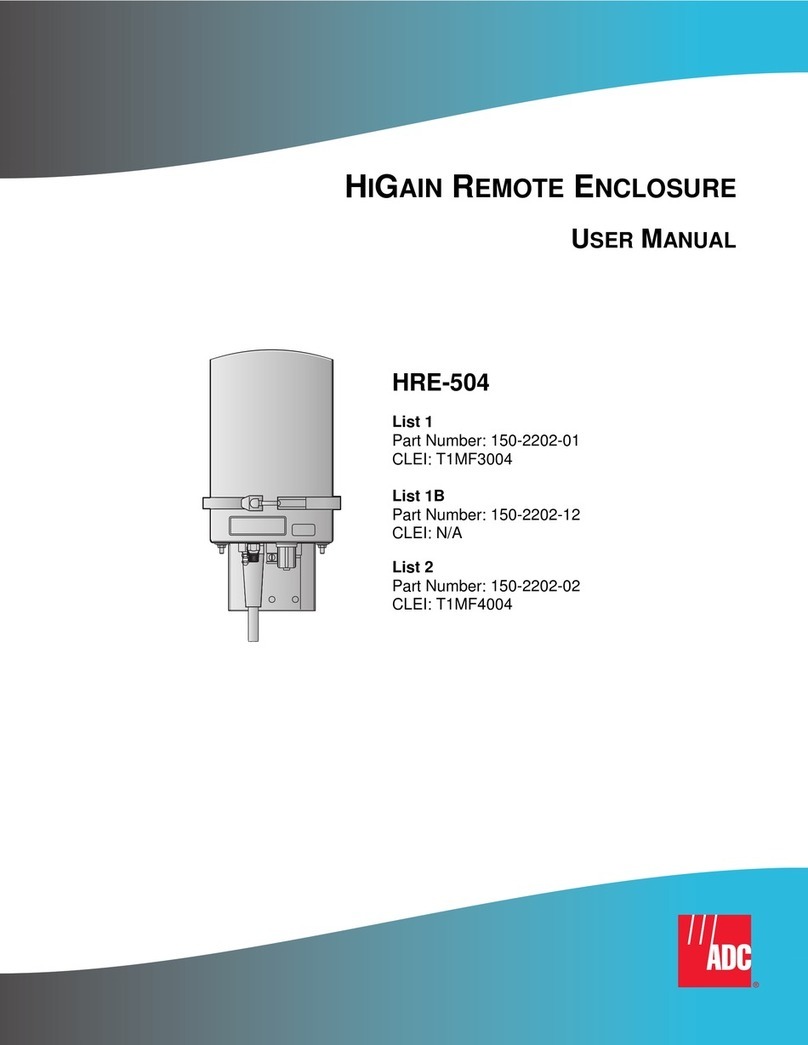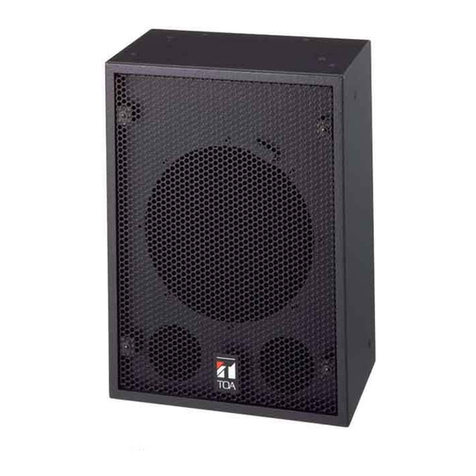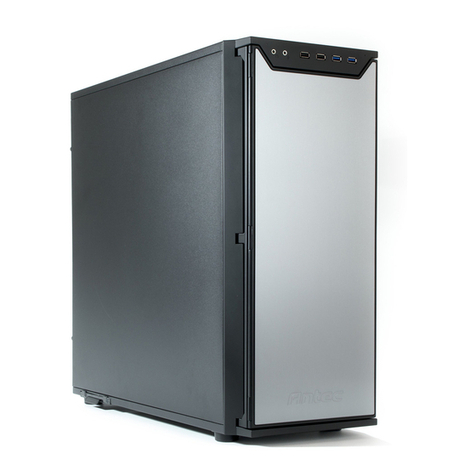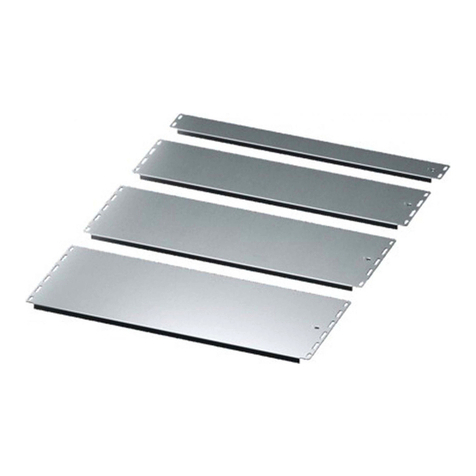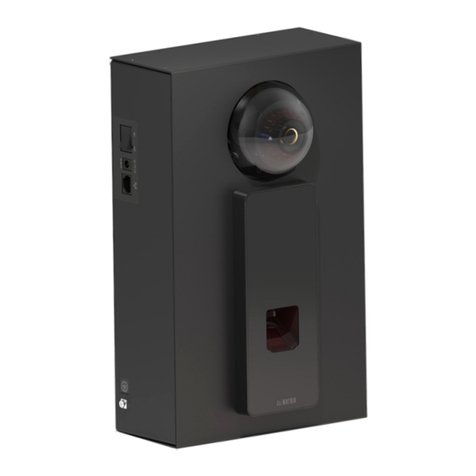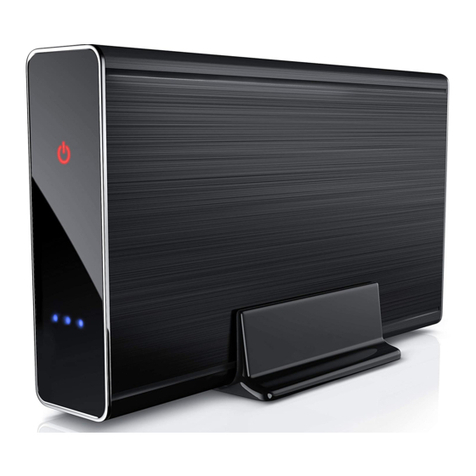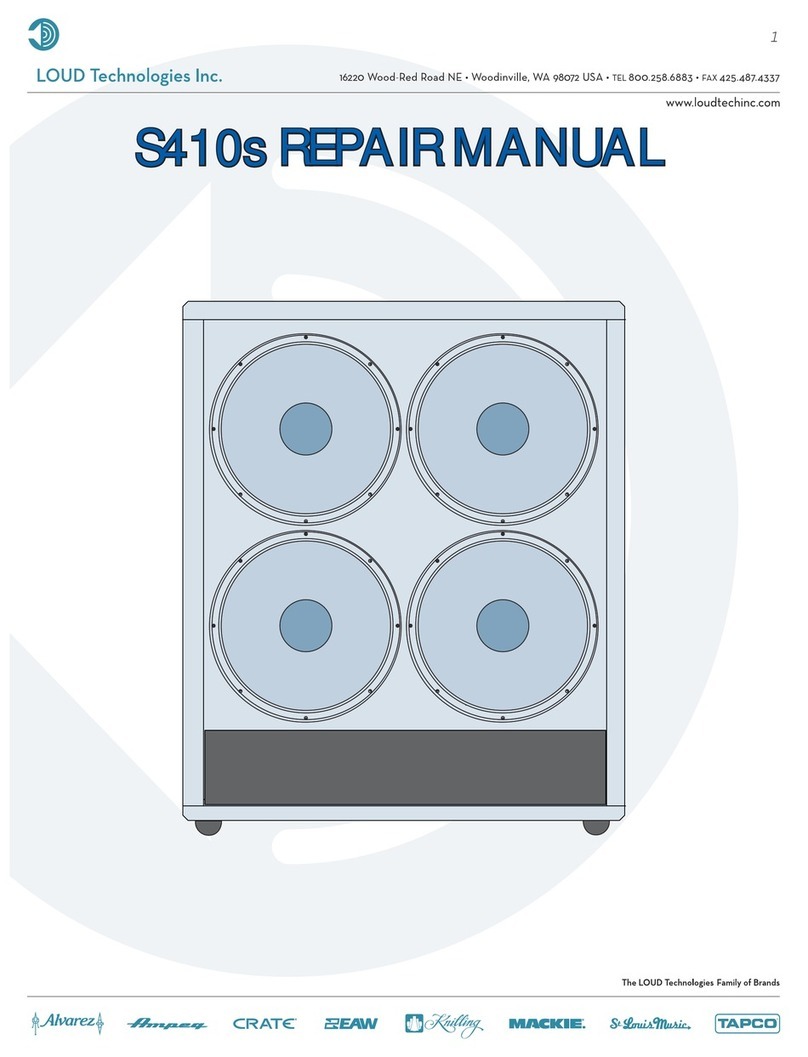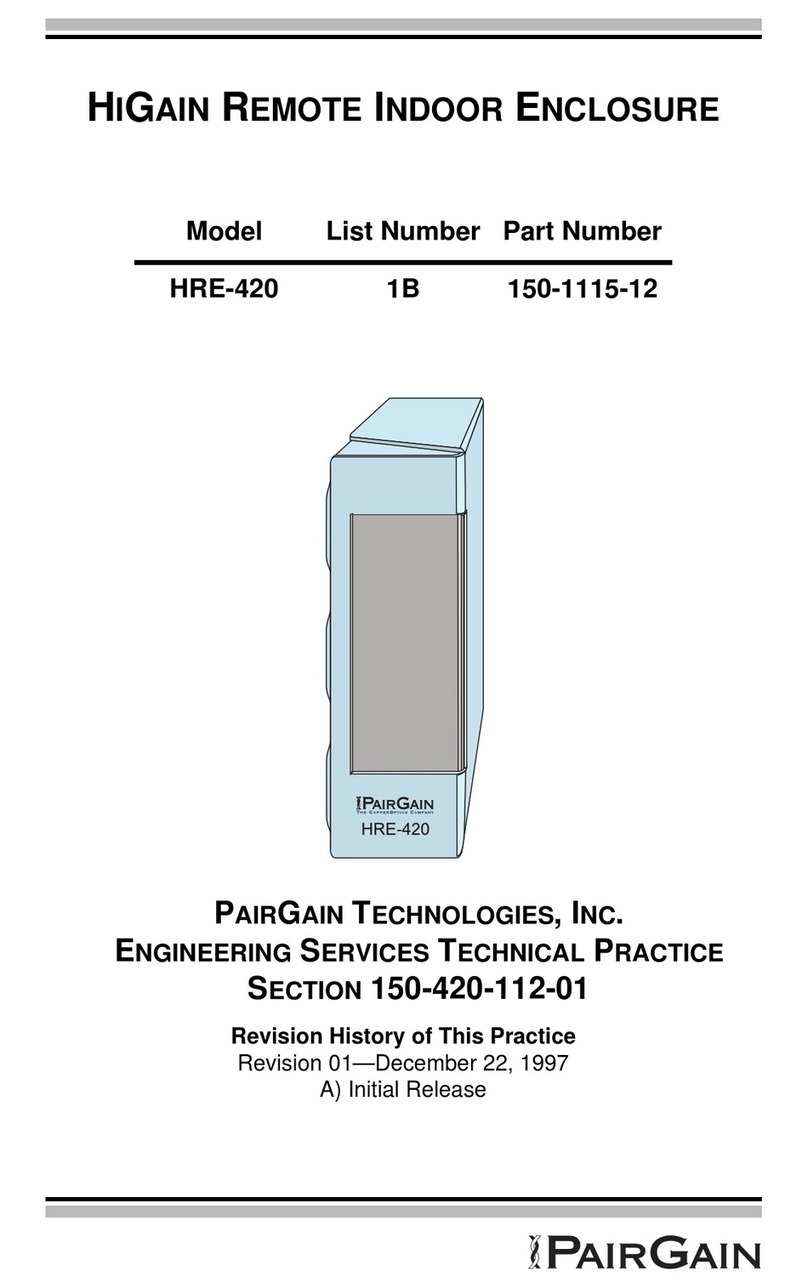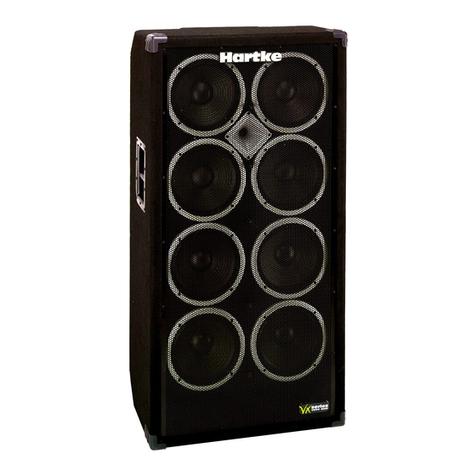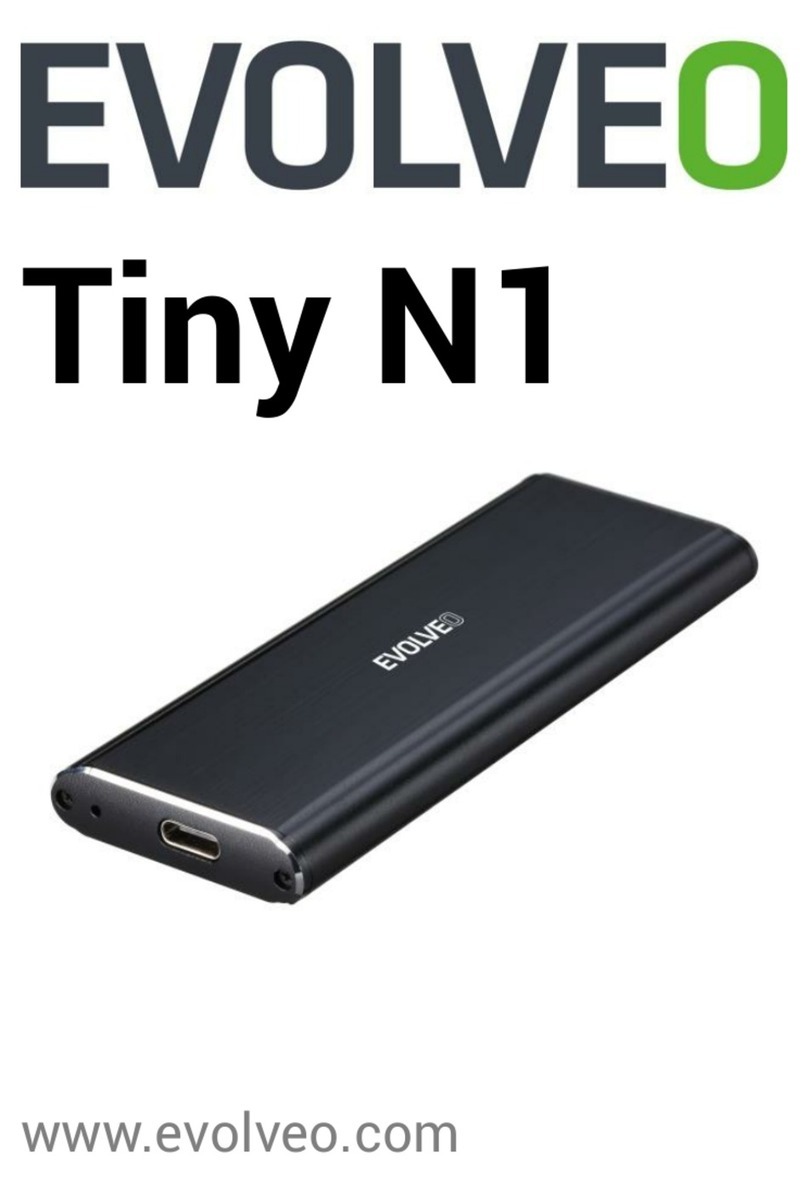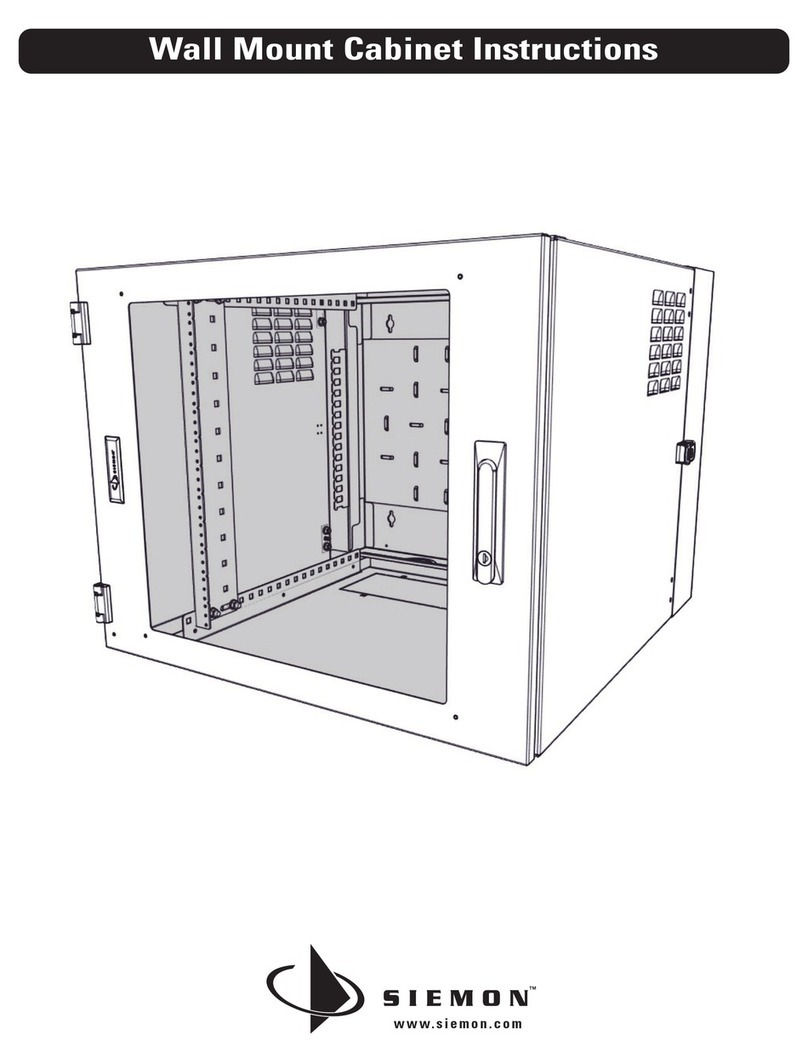ADIC Tape Array 5 User manual

Installation
and
Operating Guide
Tape Array 5 Rackmount
Enclosure

ii
Copyright Notice
Copyright ADIC 1998, 1999
The information contained in this document is subject to change without notice.
This document contains proprietary information that is protected by copyright. All rights are reserved. No
part of this document may be photocopied, reproduced or translated to another language without the prior
written consent of ADIC™.
ADIC shall not be liable for errors contained herein or for incidental or consequential damages (including
lost profits) in connection with the furnishing, performance or use of this material whether based on
warranty, contract, or other legal theory.
Printed in the U.S.A.
August 1999
Document Number 62-0115-01 Rev. D
Corporate Headquarters:
Advanced Digital Information Corporation
Shipping Address: 11431 Willows Road NE
Redmond, WA 98052
Mailing Address: P.O. Box 97057
Redmond, WA 98073-9757
Telephone: (425) 881-8004
Fax: (425) 881-2296
World-wide web: http://www.adic.com
BBS: (425) 883-3211
ADIC Europe
ZAC des Basses Auges
1 rue Alfred de Vigny
78112 - Fourqueux, FRANCE
Telephone: 33 (0)1 30 87 53 00
Fax: 33 (0)1 30 87 53 01
ADIC Technical Assistance Center: (800) 827-2822
ADIC and ADIC Europe are trademarks of Advanced Digital Information Corporation. Quantum®is a
registered trademark of Quantum Corporation. DLT™ and DLTTape™ are trademarks of Quantum
Corporation.

iii
Copyright Notice (Europe)
© Copyright ADIC Europe 1998, 1999
All rights reserved. No part of this document may be copied or reproduced in any form or by any means,
without prior written permission of ADIC Europe™, ZAC des Basses Auges, 1 rue Alfred de Vigny, 78112 -
Fourqueux, FRANCE.
ADIC Europe assumes no responsibility for any errors that may appear in this document, and retains the right
to make changes to these specifications and descriptions at any time, without notice.
This publication may describe designs for which patents are pending, or have been granted. By publishing
this information, ADIC Europe conveys no license under any patent or any other right.
ADIC Europe makes no representation or warranty with respect to the contents of this document and
specifically disclaims any implied warranties of merchantability or fitness for any particular purpose. Further,
ADIC Europe reserves the right to revise or change this publication without obligation on the part of ADIC
Europe to notify any person or organization of such revision of change.
Every effort has been made to acknowledge trademarks and their owners. Trademarked names are used solely
for identification or exemplary purposes; any omissions are made unintentionally.

iv
EMI/RFI Compliance
United States – FCC
WARNING: This equipment has been tested and found to comply with the limits for a Class A digital
device, pursuant to Part 15 of the FCC Rules. These limits are designed to provide reasonable protection
against harmful interference in a residential installation. This equipment generates, uses, and can radiate
radio frequency energy and, if not installed and used in accordance with the instructions, may cause harmful
interference to radio communications. However, there is no guarantee that interference will not occur in a
particular installation. If this equipment does cause harmful interference to radio or television reception
(which can be determined by turning the equipment off and on) the user is encouraged to try to correct the
interference by one or more of the following measures:
•Re-orient or relocate the receiving antenna.
•Increase the separation between the equipment and receiver.
•Connect the equipment into an outlet on a circuit different from that to which the receiver is
connected.
•Consult the dealer or an experienced radio/TV technician for help.
You may find the following booklet prepared by the Federal Communications Commission helpful: How to
Identify and Resolve Radio-TV Interference Problems. This booklet is available from the U.S. Government
Printing Office, Washington, DC 20402, Stock No. 004-000-00354-04.
Canada – Department of Communications
This digital apparatus does not exceed the Class A limits for radio noise emissions from digital apparatus as
set out in the interference-causing equipment standard entitled "Digital Apparatus", ICES-003 of the
Department of Communications.
Cet appareil numérique respecte les limites de bruits radioélectriques applicables aux appareils numériques
de Class B prescriptes dans la norme sur le matériel brouilleur: "Appareils Numériques", NMB-003 édictée
par le ministre des Communications.
Shielded Cables
Shielded data cables are required in order to meet FCC emissions limits. The ADIC data cable meets this
requirement. If you need a replacement cable, be sure to use an ADIC-approved shielded cable (to assure
acceptability to FCC requirements).

v
Declaration of Conformity
according to EN 45014
Manufacturer’s Name: Advanced Digital Information Corporation
Manufacturer’s Address: 11431 Willows Road NE ZAC des Basses Auges
Redmond, WA
98052 1 rue Alfred de Vigny
78112 - Fourqueux,
France
USA
Type of equipment: External Digital Linear Tape Drive Enclosure
Model No.: T5
Year of Manufacture: 1998
conforms to the following international specifications, as required by 89/336/EEC & 92/31/EEC:
EMI: EN 50081-1, EN-55022 Class A
EMC: EN 50082-1, IEC 801-2, IEC 801-3, IEC 801-4
Safety: EN 60950
Redmond, Washington USA 1 July 1998 Product Engineering Mgr.
Location Date Signature/Title

vi
Safety Warnings
This symbolshouldalertthe
usertothepresenceof
"dangerousvoltage"inside
the product thatmightcause
harmorelectricshock.
CAUTION
RISKOFELECTRICSHOC
K
DONOTOPEN
CAUTION:
TOREDUCE
THERISKOFELECTRIC
SHOCK,DONOTREMOVE
COVER(ORBACK).
NOUSER-SERVICEABLE
PARTSINSIDE.REFER
SERVICINGTOQUALIFIED
SERVICEPERSONNEL.
Caution
All safety and operating instructions should be read before this product is
operated, and should be retained for future reference. This unit has been
engineered and manufactured to assure your personal safety. Improper use
can result in potential electrical shock or fire hazards. In order not to
defeat the safeguards, observe the following basic rules for its installation,
use and servicing.
1. Heed Warnings - All warnings on the product and in the operating instructions should be adhered
to.
2. Follow Instructions - All operating and use instructions should be followed.
3. Ventilation - The product should be situated so that its location or position does not interfere with
proper ventilation.
4. Heat - The product should be situated away from heat sources such as radiators, heat registers,
furnaces, or other heat producing appliances.
5. Power Sources - The product should be connected to a power source only of the type directed in
the operating instructions or as marked on the product.
6. Power Cord Protection - The AC line cord should be routed so that it is not likely to be walked on
or pinched by items placed upon or against it, paying particular attention to the cord at the wall
receptacle, and the point where the cord exits from the product.
7. Object and Liquid Entry - Care should be taken to insure that objects do not fall and liquids are not
spilled into the product’s enclosure through openings.
8. Servicing - The user should not attempt to service the product beyond that described in the
operating instructions. All other servicing should be referred to qualified service personnel.

vii
Precautions
•Do not use oil, solvents, gasoline, paint thinners or insecticides on the unit.
•Do not expose the unit to moisture, to temperatures higher than 140ºF (60ºC) or to extreme low
temperatures.
•Keep the unit away from direct sunlight, strong magnetic fields, excessive dust, humidity, and
electronic/electrical equipment, which generate electrical noise.
•Hold the AC power plug by the head when removing it from the AC source outlet; pulling the cord
can damage the internal wires.
•Use the unit on a firm level surface free from vibration, and do not place anything on top of unit.

viii
Blank Page

ix
Table of Contents
Copyright Notice ...............................................................................................................................................ii
Copyright Notice (Europe)...............................................................................................................................iii
EMI/RFI Compliance .......................................................................................................................................iv
Safety Warnings................................................................................................................................................vi
Precautions ......................................................................................................................................................vii
Chapter 1 Introduction...............................................................................................................................................1
Equipment Description......................................................................................................................................2
Rear Panel Connectors, Switches and Indicators.......................................................................................3
Power Supplies..........................................................................................................................................4
Cooling......................................................................................................................................................5
Chapter 2 Installation ................................................................................................................................................7
Unpacking and Inspecting .................................................................................................................................8
Installing Tape Drives........................................................................................................................................8
Installing SCSI Cables, Jumpers, and Terminators............................................................................................9
SCSI Cables and Jumpers..........................................................................................................................9
SCSI Terminators ....................................................................................................................................10
SCSI ID Selection Switches ............................................................................................................................10
Installing in the Rack.......................................................................................................................................11
Chapter 3 Operation and Maintenance....................................................................................................................13
Powering on the System ..................................................................................................................................16
Normal Operations ..........................................................................................................................................16
General Guidelines ..................................................................................................................................16
Drive(s) Power-on Self-Test....................................................................................................................16
Drive Operating Conditions.....................................................................................................................18
DLT Media ..............................................................................................................................................21
Loading a Data Cartridge.........................................................................................................................22
Tape in Use..............................................................................................................................................23
Removing a Data Cartridge......................................................................................................................23
Normal Maintenance .......................................................................................................................................24
Cleaning the Drive Head..........................................................................................................................24
Cleaning the Enclosure............................................................................................................................26
Power Supplies........................................................................................................................................26
Chapter 4 Troubleshooting and Diagnostics............................................................................................................29
High Humidity.................................................................................................................................................32
When You Need Assistance ............................................................................................................................32
Appendix A Specifications......................................................................................................................................33

xTable of Contents
Blank Page

1
Chapter
1
Introduction
This Chapter. . .
pprovides a physical description of the switches, indicators and connectors on
the rear panel of the T5 Enclosure.

2Introduction
Equipment Description
The Tape Array (T5) Rackmount Enclosure can house from one to five Quantum® DLT7000 or DLT8000
SCSI tape drives in a well-integrated package for use in rackmount applications. Included on the rear panel
of the T5, 10 HD68 SCSI connectors allow separate SCSI bus connections to each drive. Five drive SCSI ID
selection switches are also included on the rear panel.
The DLT tapedrives are mounted in easily removed carriers, which slide into the front of the T5 chassis and
are retained with captive screws. The carriers contain SCSI and power connectors which dock with mating
connectors mounted inside the T5 chassis and provide all power and data connections between the drives and
the T5. The T5 Enclosure features a snap on/off front bezel, which can be easily snapped off for drive carrier
removal, and allows access to the media cartridges when in place.
Dual, redundant hot-swappable 300-watt power supplies provide all necessary operating voltages for the
DLT drives. Two cooling fans mounted on the T5 rear panel, and a self-contained cooling fan in each of the
power supplies provide drive cooling.
Figure 1-1: T5 Enclosure, Front View
Front Bezel

Introduction 3
Rear Panel Connectors, Switches and Indicators
Figure 1-2: T5 Rear Panel
Rear Panel Connectors, Switches and Indicators
Power Switch Turns on AC power to the T5 Enclosure.
AC Power Connector Plug the T5 Enclosure AC power cord into this connector.
SCSI I/O Connectors Connections for the interface cable, SCSI jumpers, and/or SCSI
terminators, which are used to connect the T5 Enclosure to the host
computer SCSI bus(ses) or to other devices on the SCSI channel.
Ten HD68 connectors allow a separate SCSI bus connection to
each drive installed in the T5 Enclosure.
Drive SCSI ID Switches Sets the SCSI ID for each drive.
Power Supply Status
Indicators Illuminates when power is applied, and the power supply is
operational. Extinguishes whenever the power supply becomes
non-operational, or power is removed.
Drive SCSI ID Switches
SCSI I/O Connectors
Power Switch
AC Power Connector
PS Status
Indicators

4Introduction
Power Supplies
Two redundant hot-swappable 300-watt power supplies provide operating voltages for the DLT tape drives
installed in the T5 Enclosure. The two supplies operate in parallel using proprietary power control and
sharing modules. Each supply plugs into the rear of the T5 and can be removed or replaced while the other
supply keeps the system fully operational. There is a normally green indicator on the T5 rear panel, at the top
of each power supply module, which extinguishes whenever the associated power supply fails, is turned off,
or is removed from the chassis.
Figure 1-3: T5 Rear Panel
Power Supplies

Introduction 5
Cooling
The T5 enclosure is cooled by four fans, two of which are contained in the power supply modules and whose
status is reflected by the power supply status indicators. The other two fans are mounted on the chassis rear
panel and are easily removed and replaced while the system remains in operation.
Figure 1-4: T5 Rear Panel
Chassis Fans
Power Supply Fans

6Introduction
Blank Page

7
Chapter
2
Installation
This Chapter. . .
pexplains the steps necessary to install your T5 enclosure.

8Installation
Unpacking and Inspecting
Unpack the T5 chassis and visually inspect for any damage that might have occurred during shipment. Retain
the shipping carton in case reshipment is necessary.
Remove the top cover of the chassis and inspect the power supplies and cabling for component damage. If
any damage has occurred, notify ADIC immediately.
Each shipping carton should contain the following:
•A T5 Enclosure chassis with two removable power supply assemblies and internal SCSI data cables, as
ordered.
•Accessories box containing this Installation and Operating Guide, a right and a left side rack mount
support bracket, and an accessory bag containing an AC power cord and hardware necessary to rack
mount the enclosure.
Installing Tape Drives
1. Insert each drive carrier assembly into the unit. Check the carrier to insure proper docking connections.
2. Fully tighten the captive screw at the top and bottom of the carrier to secure it in the T5 chassis.
Caution
When inserting a carrier, be sure that the orientation of the carrier is
correct. The SCSI data cable connector should be nearest the top of the
chassis.

Installation 9
Installing SCSI Cables, Jumpers, and Terminators
Follow the steps on the following pages to connect your T5 to one or more SCSI busses. This involves
installing SCSI cables, jumpers (daisy chain cables), and terminator(s) onto the SCSI I/O connectors on the
rear panel of the T5.
Note
The interface cable(s) must be shielded – ADIC can supply you with the correct
type(s).
The T5 Enclosure can contain up to five SCSI DLT tape drives. Listed below are the SCSI configurations
supported by the T5 Enclosure:
•Each DLT drive can be connected to a separate SCSI bus, or from two to five drives can be daisy-
chained together and connected to the same SCSI bus.
•Each SCSI bus can be either single-ended or differential. They must each match the SCSI host they are
connected to.
•Termination can be active or passive. ADIC recommends using active termination on a single-ended
bus.
•All termination must be external. Never use internal terminators to terminate the drives.
SCSI Cables and Jumpers
1. Attach one end of the SCSI interface cable(s) to the connector(s) shown on the rear of your T5
Enclosure. Press firmly and secure the jackscrews.
2. Attach the other end of the SCSI interface cable(s) to the external connector(s) on the SCSI interface
card(s). Press firmly and secure the jackscrews.
Note
The jackscrews at both ends of the SCSI cable must be securely fastened in
order for the drives to communicate properly with the host computer.
3. If daisy-chaining two or more drives together for connection to a single SCSI bus, attach one end of the
SCSI jumper cable to one of the drives.
4. Attach the other end of the SCSI jumper cable to the external connector on an adjacent drive.

10 Installation
SCSI Terminators
External SCSI bus terminators should be used with either single-ended or differential drive configurations.
1. Install any required external terminator(s) on the appropriate SCSI connector(s) on the rear panel of
your T5 Enclosure.
Note
A drive should only be terminated if it is the last physical device on a SCSI bus.
SCSI ID Selection Switches
The SCSI ID selection switches are located at the top, near the center of the T5 rear panel. Each switch has
sixteen positions (0 through 15) and the selected ID is shown in the switch window.
1. To select a higher SCSI ID, push the “+” button. To select a lower SCSI ID, push the “-” button.
Notes
•Each device attached to an individual SCSI channel must be assigned a
unique SCSI ID.
•SCSI IDs are preset at the factory to the following: Drive 1 = 1, Drive 2 = 2,
Drive 3 = 3, Drive 4 = 4, Drive 5 = 5.
Table of contents
